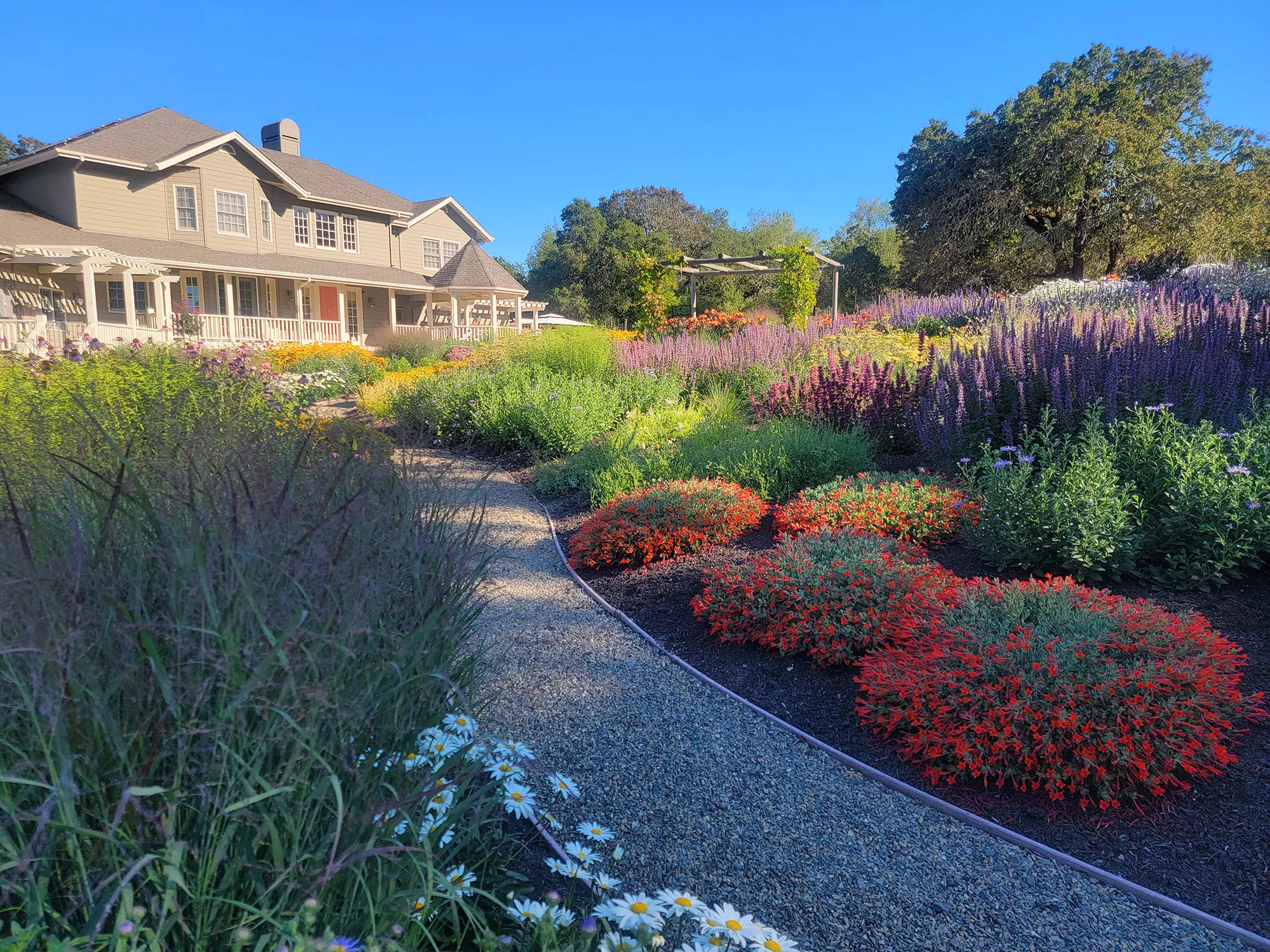
Why Walkways Are a Critical Aspect of Your Landscape
Adding a walkway to your landscape is a great way to invite you to explore the spaces within your landascape make it feel more inviting. The benefits of a well-designed and adequately installed walkway go beyond aesthetics. It as they can help connect garden spaces while creating boundaries to separate different destinations within the garden.use areas.
A well planned walkway gives direction for your eyes as well as where to walk and provides space to move through the landscape without trampling on surrounding plants or compacting soils in the planting areas. A walkway provides direction and allows visitors to walk through your garden without trampling your other landscaping horticulture.
Designing and executing a strategic and functional walkway in your landscaping takes careful consideration and planning. can take time. When working with a professional landscaping contractor, their experience and expertise make a pathway project of any scale a dream come true. Inspired Landscapes is an award-winning landscaping design and installation company in Sonoma County. Our team of experts has transformed gardens across the county into beautiful oases.
When choosing where and how to incorporate a walkway through your landscape, contact our team by calling (707) 395-7474.
The Importance of Walkways in Your Landscaping
- A well-designed walkway helps organize your outdoor space by cleaning clean borders. can help make your outdoor space look cleaner and more organized.
- A walkway can be designed to provide attractive routes of access to various spaces in your landscape. tie your favorite spaces into your landscape.
- Strategically placed walkways provide direction and can help users keep their feet dry when moving through the landscape. They also reduce soil compaction in lawns and landscape beds.
- Walkways in your landscape set the mood for your outdoor area. You can incorporate different path styles in your walkway design to create the desired environment in your landscape. For example, a curved, meandering path can be used to create a relaxing and casual environment. or enhance the rustic feel of a home. Straight lines and angular forms cast a contemporary theme across the landscape creating formal defined borders. You can also use different styles to make sense of mystery and openness.
- A walkway provides an even and safe surface to walk on. A walkway made from porous water-repellent materials can help reduce slip, trip, and fall hazards.
How to Create the Perfect Walkway?
Walkways are strategic design elements of landscaping. When deciding where to put your walkway, consider your plants and existing and planned structures. The number of people using a walkway simultaneously will dictate its width. Walkways are designed to be used by two or more people simultaneously and should be a minimum of four feet wide. three or more comprehensive.
When choosing walkway materials, consider the intended purpose of the garden path. For the most stable and flat surface precast concrete pavers, cut and faced naturals stone, bricks, or concrete are great options. They allow for a smooth walking surface and unmatched longevity with minimal maintenance. For a rustic aesthetic flagstone, decomposed granite, or crushed rock pathways can be used providing a wide range of colors and textures to compliment your landscape installation. Use brick or cut stone to create a walkway in a formal landscape. If your landscape has a natural or organic style, use crushed shells, flagstones, gravel, mulch, or steppingstones to create your walkway.
When planning your walkway you must consider how it might affect drainage in the area. Ensuring you don’t accidentally create low points that will gather water or block existing surface drainage in planting areas is of high importance. Alternatively using pathways which are permeable such as crushed rock, decomposed granite, or stepping stones allows for water to easily pass through the surface of the walkway. allow for a slight slope to improve drainage on one side of the path. Use previous surfaces made from steppingstones, gravel, or porous concrete for walkways, as these materials allow water to seep slowly into the ground.
Here are some tips to consider when creating a walkway:
- When deciding the location of your walkway, observe the natural flow of foot traffic in your backyard.
- Strategically place walkway pathway lights to highlight specific walkway features or elements at night. Walkway lighting will also improve walkway safety, allowing you to enjoy your landscape at night.
- Widen your walkway at specific points near your patio, a shady bench to rest on, or a garden of flowers. Incorporate curves into a meandering walkway to allow for a natural look and feel in your backyard and as well as visual interest.
- Add steps to your walkway to give an added dimension by allowing the use of new shapes and materials.
- Try to keep the walkway design as consistent as possible. If you have a formal or contemporary home, use symmetric straight lines and angular shapes to reflect the existing architecture. Flagstones are ideal for country-style homes. For a cottage or rustic style home lean into organic forms with natural uncut stone and by incorporating placement boulders into the borders of the pathways. When determining the best design principles for your space, consider weather conditions and the potential uses of your walkway.
- Consider whether you want to create different zones, draw traffic from one area of your landscape to another, ensure a natural traffic flow or create areas where users can relax or spend time. For example, you can create a shady nook and place chairs so users can sit in the room while reading their favorite books or having engaging conversations with each other.
What Factors to Consider When Choosing Walkway Materials?
When choosing walkway materials, the two most important factors to consider are your budget and the amount of shade. The allocation of the project will dictate what materials are available.
Walkways and hardscapes in general tend to be more expensive per square foot than other elements of a landscape project and therefore budget can be a major factor in choosing your materials. Natural stone such as travertine or bluestone fit for high end designs but might not be the right choice for a small bungalow. Precast concrete pavers give the elegance of a natural stone patio with some added budget savings. Stepping stones or crushed rock pathways are functional and beautiful while being significantly more budget friendly.
The amount of shade is another essential factor when deciding which materials to use in your walkway. Moss and mildew grow on stone and concrete, creating slip hazards. Instead, consider trail mix – a mixture of aggregates – for pathways in shady areas. You can also use pavers for a walkway in the shade.
What Are Some Tips for Maintaining Your Walkway?
Your walkway is exposed to the elements and will become weathered over time. takes many punishments daily. A dirty or damaged walkway can affect the aesthetic appeal of your outdoor space. Follow these tips to keep your walkway in top shape all year round.
- Keep your walkway clean. To prevent dirt buildup, sweep regularly.
- Repair cracks as soon as possible.
- Pressure wash your walkway annually.
- For stubborn stains, use a light cleaning product such as Simple Green. mixture of dish soap and water.
Inspired Landscapes is a trusted landscaping company serving Sonoma County. Our professionals have years of experience designing and installing beautiful and functional landscapes. Are you ready to take the following steps in making your gardening landscape dreams a reality? Contact our team by calling (707) 395-7474.

Owner, Inspired Landscapes LLC
Matthew Ripley is the owner of Inspired Landscapes LLC, a Healdsburg based landscape design, installation, maintenance, and irrigation firm serving Sonoma County. His work blends horticultural expertise with sustainable practices, drawing creative influence from Sierra backpacking and Sonoma winery estates to craft gardens that invite wildlife and year round color. Client testimonials highlight his design leadership on residential, estate, and winery properties across the region.





